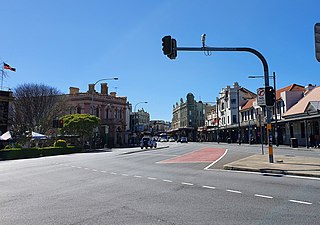
Newtown, a suburb of Sydney's inner west, is located approximately four kilometres south-west of the Sydney central business district, straddling the local government areas of the City of Sydney and Inner West Council in the state of New South Wales, Australia.

Arts Centre Melbourne, originally known as the Victorian Arts Centre and briefly called the Arts Centre, is a performing arts centre consisting of a complex of theatres and concert halls in the Melbourne Arts Precinct, located in the central Melbourne suburb of Southbank in Victoria, Australia.

Jazz music has a long history in Australia. Over the years jazz has held a high-profile at local clubs, festivals and other music venues and a vast number of recordings have been produced by Australian jazz musicians, many of whom have gone on to gain a high profile in the international jazz arena.

The Queensland Performing Arts Centre is part of the Queensland Cultural Centre and is located on the corner of Melbourne Street and Grey Street in Brisbane's South Bank precinct. Opened in 1985, it includes the Lyric Theatre, Concert Hall, Playhouse and Cremorne Theatre.
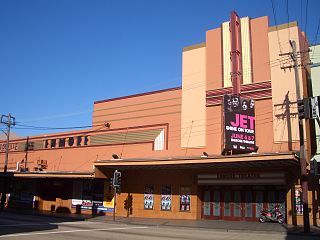
The Enmore Theatre is a theatre and entertainment venue in Enmore, New South Wales, Australia.
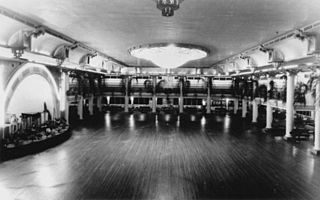
The Cloudland Dance Hall, originally called Luna Park, was a famous entertainment venue located in Bowen Hills, Brisbane, Queensland, Australia. It was demolished in 1982 and the site was subsequently developed into an apartment complex.
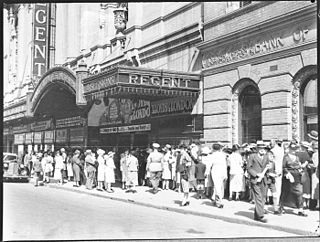
The Regent Theatre was a heritage-listed cinema and entertainment venue in George Street, Sydney, New South Wales, Australia, built in 1928 as a flagship for Hoyts, and was demolished in 1988 by property developer Leon Fink.

Sydney Festival is a major arts festival in Australia's largest city, Sydney, that runs for three weeks every January since it was established in 1977. The festival program features over 100 events from local and international artists and includes contemporary and classical music, dance, circus, drama, visual arts and artist talks. The festival attracts approximately 500,000 people to its large-scale free outdoor events and 150,000 to its ticketed events and contributes more than A$55 million to the economy of New South Wales.

Wollongong Conservatorium of Music is a centre for music education, community music-making and performance, serving the city of Wollongong, New South Wales, Australia.
Joe Lane was an Australian Bebop jazz vocalist based in Sydney.
Horst Liepolt was a jazz producer and artist.

Vernon Treweeke was an Australian psychedelic artist. He has been termed the "father of psychedelic art in Australia". In the late 1960s he was deemed to be "Australia's leading practitioner of abstract eroticism."

Mary Elizabeth Kathleen Dulcie Deamer was a New Zealand-born Australian novelist, poet, journalist, and actress. She was a founder and committee member of the Fellowship of Australian Writers.

The State Theatre is a 2034 seat heritage listed theatre located at 47–51 Market Street, in the Sydney central business district in the City of Sydney local government area of New South Wales, Australia. The theatre was designed by Henry Eli White with assistance from John Eberson and built between 1926 and 1929. It hosts film screenings, live theatre and musical performances, and since 1974 it has been the home of the annual Sydney Film Festival. It is also known as State Building and Wurlitzer Organ. The property is privately owned. It was added to the New South Wales State Heritage Register on 2 April 1999.
Limelight is an Australian digital and print magazine focusing on music, arts and culture. It is based in Sydney, New South Wales. Originally published in 1976 by the Australian Broadcasting Corporation (ABC), as ABC Radio 24 Hours, or simply 24 Hours, since March 2018 it has been published independently by Limelight Arts Media, owned by music lovers Robert Veel and Bruce Watson.
Frank James Coughlan was an Australian jazz musician and band leader. He is described in the Australian Dictionary of Biography as "One of the most influential musicians in the development of jazz in Australia."
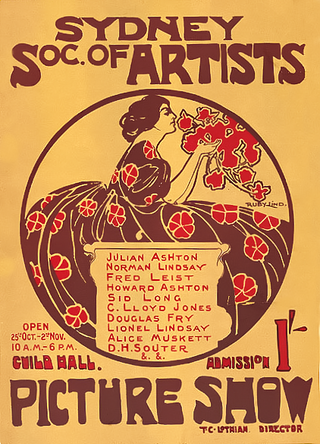
The Society of Artists was an influential Sydney based group of progressive artists who staged annual exhibitions from 1895 to the 1960s. The Society included many of Australia's best artists of the time. It lapsed during the mid 1960s.

The Garrick Theatre was a theatre and music hall at 79–83 Castlereagh Street in Sydney from 1890 to 1929. The theatre was renamed the Tivoli Theatre in 1893 and operated as a popular vaudeville venue. It was destroyed by fire in 1899 and rebuilt. The theatre closed in 1929.
The Australian Art Orchestra (AAO) is one of Australia's leading contemporary ensembles. Founded by pianist Paul Grabowsky in 1994, it has been led by composer/trumpeter/sound artist Peter Knight since 2013 and led by pianist/composer/producer Aaron Choulai since 2023. The Orchestra explores relationships between musical disciplines and cultures, imagining new musical concepts that reference how 21st century Australia responds to its cultural and musical history.
Dance Halls of Brisbane in the twentieth century were popular venues for entertainment, socialising and reflected styles of music, architecture, popular culture and city planning.
















